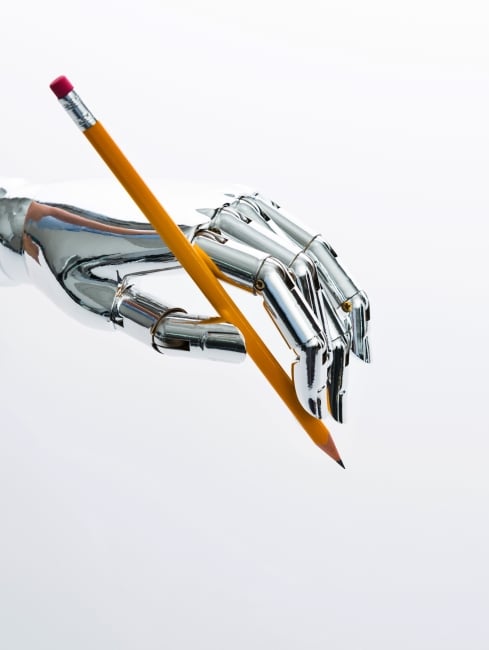You have /5 articles left.
Sign up for a free account or log in.

It’s been more than a year since ChatGPT was released, yet people in academe still constantly bring up the topic, and the questions they raise are far from answered. From the advantages it offers to the ethical dilemmas it poses, ChatGPT remains a controversial issue. Some universities embrace it, others ban it and still others walk a line between the two extremes.
I, too, have been grappling with the idea of ChatGPT and its use. I’m neither in the “Let’s use its full potential for everything” camp nor in the “Let’s ban it completely” one. In fact, I am very much struggling to define how I feel and what I think about it. On the one hand, I support progress and use of tools that aid learning and skill development. On the other, I’m skeptical that the use of AI programs isn’t infringing upon authenticity and ownership.
In this article I will share my thoughts on the use of ChatGPT by graduate students and postdocs as an aid in writing—specifically for the first draft of a project. I argue against its use for this particular purpose, because I believe it robs us all of the opportunity to go through the creative process of writing and producing something that’s authentic and written in our own voice. I see the question of whether or not to use ChatGPT as a triple-A issue—one of authorship, authenticity and audience.
Authorship
My 4-year-old daughter loves drawing. She produces at least 20 new drawings every day. She loves coloring, too, and I’m gifted daily with many examples of her work.
Recently, on a cold Sunday, she was drawing one picture after another, and she presented me with each one, explaining in detail what she did in each. She soon ran out of her favorite paper and switched to coloring in a printed-out image. As soon as she finished the first one, as before, she came to me and said, “Mom, look what I drew.” I complimented her on her use of colors and staying within the lines, but I couldn’t help but remind her that she didn’t draw it. I explained that she enriched it by coloring it and was very creative about the colors she used, but the drawing itself wasn’t hers. She pushed back and pointed out all the details that she added: dots on a dress, a different hairstyle, some flowers and butterflies. If you knew my daughter, you’d understand why I didn’t give up and continued the discussion with her.
I was inspired and intrigued by our conversation, and it led me to thinking about whether we in academe can claim a piece of writing as ours if AI tools generate it and we then just revise and polish it. Did adding details like flowers and butterflies in my daughter’s coloring sheet make it her drawing, or did she skip the creative process through which we grow the most and develop our skills?
When it comes to jobs for graduate students and postdocs, for instance, the vast majority will require “excellent writing skills,” and I doubt that will change to “excellent use of AI tools for writing.” Instead of learning how to give a good prompt, why not actually learn how to write?
Authenticity
I used to teach first-year writing for multilingual college students. I helped students develop their own writing process and use it to grow their writing skills. A second-language user of English myself, I’ve always understood the struggle of writing in another language and the temptation to get as much help as possible. I know for a fact that most native English writers face the same challenge of staring at a blank page for way too long. This is where I’ve heard people try to make the case that we should encourage our students to use AI to develop the first draft of their paper, CV or résumé. And that is where I push back.
When I was a first-year master’s student in linguistics, I was introduced to the concept of shitty first drafts, a concept Anne Lamott wrote about in Bird by Bird. My immediate reaction was the shock of the word choice in academe—and then a feeling of liberation. There is so much freedom, beauty, creativity, messiness and authenticity in the process of getting the first, shitty draft that’s too valuable to be replaced by the quickly generated AI product. I am yet to be convinced that someone’s way of thinking won’t be altered, as well as the way they go about writing, when they are rewriting a draft produced by ChatGPT.
You could argue that there is little difference between using ChatGPT to get the first draft and looking at other people’s examples of writing, since our thinking will be influenced by the examples we’ve seen. While I agree that looking at precedents influences our own writing, a draft based on what we’ve read is still driven by our own creative process and our own critical thinking as we curate what we’ve learned from the model writing.
In English composition, there is a concept called apprenticeship writing. In that model, a novice writer learns the craft by adopting and copying what the expert writer does. For example, a graduate student working on their first publication is unlikely to be taught how to do it. They’ll learn by reading their adviser’s papers and those of other authors in the field. They’ll then produce the first draft, which will be (heavily) edited by the adviser. It’s from the red ink on paper and tracked changes in a Word doc that the student learns and (hopefully) develops their own style, too.
Yet when it comes to an AI-generated first draft, it will be hard for a novice and insecure writer to significantly rewrite and make it their own, consequently robbing them of an opportunity to work on their writing-skill development and ability to produce a piece of writing even when the internet is down. In the ever-changing world where we can lose everything in a second, and where a worldwide pandemic can alter everything, our knowledge and skills are two things that cannot be taken away.
Audience
Any piece of writing must be written with the intended audience in mind. That requires many choices that even the most thoughtfully crafted AI prompt cannot address, because those choices involve things like culture, history, context and human knowledge outside the reach of AI, like personal connections. For instance, I’ve heard arguments for encouraging those who speak a different language to use ChatGPT to help them with English. However, as a former teacher of English as a second language, I would advise against it. It is obvious when a nonnative speaker uses ChatGPT. If we truly strive to be more inclusive, equitable and open to difference, how will we achieve that if we encourage students to use a tool that will provide the same or very similar first draft to everyone?
The HR office at a colleague’s institution did an analysis of applicants’ CVs and noticed a pattern of words and expressions used in CVs and résumés that traced back to the use of AI. So if you are a student applying for a job, chances are you are giving similar good prompts as many others and submitting your application to the same people, who will quickly notice the similarity. Therefore, instead of using ChatGPT to develop your first draft, you should create your own—revising, receiving feedback from others and then, finally, if you still feel like you need it, using AI to polish it.
Why Write Your Own First Draft?
I recently had an opportunity to watch an AI expert demonstrate how to use ChatGPT and get the most out of it. While I understand that it’s not an easy task to come up with good prompts, I’m worried about how ChatGPT may quickly move from a tool that just makes things faster to a one that does the work for us, so we never really learn how to do something on our own.
People often compare the current situation with ChatGPT to the introduction of calculators and the fear that, as a result, no one would be able to add two numbers on their own. That hasn’t really turned out to be true, and everyone still learns how to add, subtract, multiply and divide on their own. But while math and writing share a lot of similarities, writing requires much more than simply adding words to form a sentence. What we bring to the meaning of words is irreplaceable.
CVs and résumés are at the top of the list when it comes to recommendations for using ChatGPT to get the first draft. I recently had an opportunity to review many CVs and résumés for a job position at my institution, and the ones that achieved the hard task of telling a career story through what’s traditionally a rather dry piece of writing were the most successful. I support the idea of teaching students to understand how AI is used in the applicant tracking system, so they can keep it in mind as they develop the first draft of their CV. But that’s different from having ChatGPT generate one for you.
Writing the first draft is incredibly hard for most of us, but it doesn’t have to be. Below I offer practical advice on how to go about doing so and getting the best out of the process.
- Let go of the perfectionism that most of us suffer from when it comes to writing. It’s called the shitty first draft for a reason. Use the opportunity to do a brain dump. Imagine you have a basket full of Lego blocks and then empty the whole basket onto floor and start building. Go back to the creative child in you and let that child play and follow their instincts. What comes out of it may be ugly or not make much sense, but you can let the perfectionist in you come back when you start rearranging, cleaning up and polishing your words.
- “There is no such thing as good writing, only good rewriting,” said Robert Graves, an English poet. Once you move past the blank page, you’ve done the hardest part of work, and now it’s a matter of dressing up your writing for the occasion—arranging what you wrote in a way that matches the task requirements. If it’s a CV, make sure it responds to the job post, and don’t forget to keep your audience in mind.
- Get feedback. Ask different people— a friend, a colleague, your adviser or an outside professional—to look at your CV and give you some feedback. Remember to put it in context. When you share your CV, make sure you share one or two job posts that you’re applying for so they can give you the most useful feedback.
- Use career services. Career coaches can be far better than ChatGPT in helping you with your CV or résumé. Work with them. Share your draft and ask them to critique it. They will probably be able to point out things that you forgot to mention, like the mentoring you provide to your younger colleagues or the conference in your field that you helped organize and showcases your organizational skills.
I will conclude with a little visual exercise. Imagine you start using AI tools and do pretty well. You’re advancing, you’re turning to it for more and more things, and it becomes an integral part of your productivity. Now imagine that one day it all goes away, and you’re left to your own devices. How are you feeling? How are you managing? What’s at stake? What could you lose? Your job? Your reputation? Your confidence?




